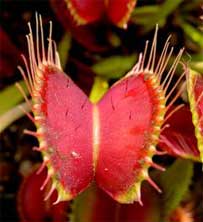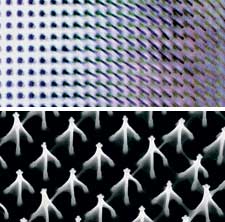| Posted: January 30, 2007 |
Nanotechnology inspired by venus flytrap |
|
(Nanowerk News) A keen sensitivity to their environment allows venus flytraps to ensnare their insect meals. Gently graze their trigger hairs, and the carnivorous plants will clamp together their jawlike leaves. Such responsive behavior, which is intrinsic to natural systems, is becoming a key requirement for advanced artificial materials and devices, presenting a substantial scientific and engineering challenge. Materials scientists have now managed to replicate this acute environmental sensitivity on the nanometer scale ("Reversible Switching of Hydrogel-Actuated Nanostructures into Complex Micropatterns"). Dynamic control over the movement and orientation of surface nanofeatures at the micron and submicron scales may have exciting applications in actuators, microfluidics, or responsive materials.
|
  |
| Left: The edges of a Venus Flytrap leaf are equipped with teeth-like protrusions called cilia, while the inside has red pigmentation that attracts insects. Notice the trigger hairs on the inner trap surface (Image: Wikimedia Commons); Right: Nanocolumns 5 mm long progressively lean over on a water droplet's drying edge (top) and form microsnares (Image: Science)
|
|
Joanna Aizenberg, of Bell Laboratories in Murray Hill, N.J., and coworkers created their own adaptive material by partially covering an array of slender silicon nanocolumns with a layer of flexible hydrogel. The nanocolumns were put in motion by the "muscle" of the hydrogel, which swells or contracts depending on the humidity level.
|
|
In moist air, water plumps up the hydrogel so that the nanocolumns stand upright. Dry surroundings strip moisture from the hydrogel, making it pull taut across the array, tilting the columns.
|
|
By further controlling the stress field in the hydrogel, the formation of a variety of elaborate reversibly actuated micropatterns was demonstrated.
|
|
By etching patterns onto the array's substrate, Aizenberg's group can choreograph the columns' movement. They can prompt the spikes to snap together in four-pronged snares or to blossom into a field of microflowers.
|
|
"Such complex patterned movements would be impossible in the other reported artificial systems, in which polymers are actuated by an electric or magnetic field," Aizenberg says. Potential applications include a coating that's hydrophobic in humid air and hydrophilic in dry air.
|


